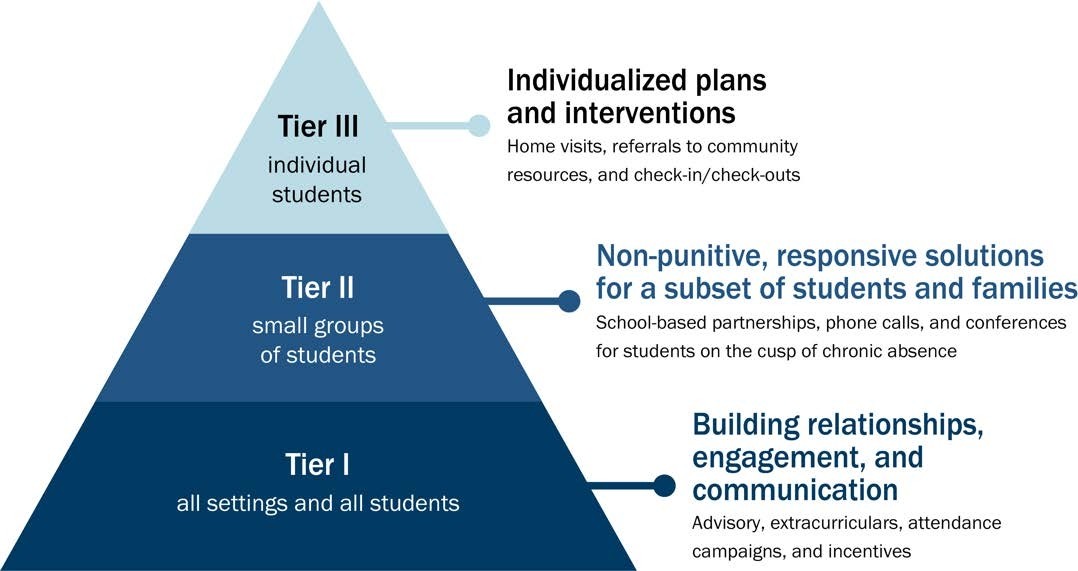Reducing Chronic Absenteeism: Lessons From Community Schools

What is the challenge?
The national rate of chronically absent students—those missing 10% or more of school days—nearly doubled from 2018 to 2022, reaching 28%. Chronic absenteeism is highest in school districts serving students and families from low-income backgrounds, and research shows that chronically absent students are more likely to fall behind academically, disengage socially, and drop out of school altogether. Because absenteeism is strongly associated with these critical student outcomes, policymakers, educators, and researchers should examine both the causes of chronic absenteeism and effective strategies to alleviate it.
What is a research-backed solution?
There is a strong and growing research base supporting the effectiveness of community schools, including their effectiveness at mitigating chronic absenteeism and its varied underlying causes. Well-implemented community schools are positioned to offer a comprehensive and multilayered approach to improving student attendance. Drawing upon local partnerships, community family engagement, integrated supports and services, data use and continuous improvement, and targeted interventions to repair students’ relationship with school, they can holistically address the multifaceted factors contributing to chronic absence. Support and funding for community schools have increased in recent years at both the federal and state levels, enabling widespread implementation of the strategy nationwide.
What Does It Mean to Be a Community School?
Community schools organize in- and out-of-school resources and supports such as mental health services, meals, health care, tutoring, internships, and other learning and career opportunities that are tailored to the goals and needs of students and families. They also cultivate a welcoming and safe school environment and provide instruction that invites students’ multifaceted identities and backgrounds into the classroom to support rich and inclusive learning. This whole-school strategy brings educators, local community members, families, and students together to make collaborative decisions; prioritizes student learning, well-being, and engagement; and turns schools into community hubs.
While community schools adopt different structures and practices depending on the needs and assets of the school and surrounding community, they often share common site-level practices. These include: (1) expanded, enriched learning opportunities; (2) rigorous, community-connected classroom instruction; (3) a culture of belonging, safety, and care; (4) integrated systems of support; (5) powerful student and family engagement; and (6) collaborative leadership and shared power and voice. These whole child practices are best implemented when there is a shared vision and purpose, trusting relationships are formed between members of the school community, and decision-making is both data-informed and inclusive.
Community school coordinators and other specialized personnel are commonly central figures in community schools who support and manage the integration of these school features.
Source: Community Schools Forward. (2023). Framework: Essentials for community school transformation.
What are the effective elements of this solution?
The four community schools highlighted in this short report are committed to meeting students’ and families’ diverse needs so youth can learn and thrive, and their efforts have dramatically reduced chronic absenteeism since the pandemic. Their approaches focus on ensuring that students consistently attend school and are cognitively, socially, and emotionally supported once they get there. While the featured community schools operate in disparate settings and have varying programmatic features, they embrace common approaches that have allowed them to effectively achieve this goal:
- Improving Family Engagement. With a focus on building trusting relationships with families, the schools have engaged families in attendance efforts, including phone calls and texts for unexcused absences, outreach campaigns focused on the importance of consistent attendance, and home visits to connect students and families with needed resources.
- Increasing Student Connectedness and Relationship Building. Knowing that reinvigorating students’ desire to be in school, to learn, and to be with friends is key to improving attendance, these schools have created advisory groups, mentorship programs, and a wide range of extracurricular activities that incorporate student interests and facilitate friendships.
- Systematically Tracking and Analyzing Data. Developing consistent systems for collecting, tracking, and analyzing attendance data helps school staff examine attendance patterns, identify students nearing or exceeding the chronic absenteeism threshold, and develop targeted supports and intervention strategies.
- Utilizing Tiered Systems of Support. Leveraging differentiated approaches—from universal strategies like attendance incentives and relationship-building opportunities to targeted interventions such as home visits and referrals to community resources for students who need more intensive support—helps schools meet individual and family needs and positively impact student attendance.

- Leveraging Partnerships. Partnerships with external organizations that provide housing support, before- and after-school programming, and mental health services are critical for addressing specific attendance barriers.
- Deploying Community School Coordinators. Given the range of challenges that can contribute to chronic absenteeism, efforts to increase attendance require school staff to identify why students are missing school and support families in overcoming barriers to attendance. This is time-intensive and skilled work. From data analysis to family engagement and partnership management, community school coordinators play a pivotal role—one that is essential to building cohesive systems that effectively address the unique needs of students and families and lead to increased attendance.
Reducing Chronic Absenteeism: Lessons From Community Schools (fact sheet) is licensed under a Creative Commons Attribution-NonCommercial 4.0 International License.
